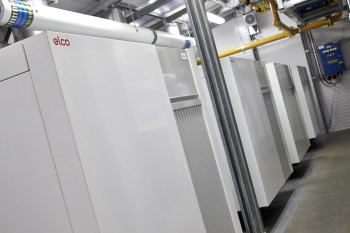Beyond published efficiency figures

With energy efficiency a key factor in the specification of commercial boiler plant, flexibility in system design is a high priority. Peter Gammon of Elco UK, stresses why a boiler’s water content can play a vital role in a system and how lifecycle costs need careful consideration.
In the world of commercial-heating specification, battle lines are often drawn in the plant room. Manufacturers claim that their individual products outperform competitor units and are the obvious choice for the project in question. The practice has carried on for decades but has, quite honestly, lost its relevance in today’s market. And the reason why? Legislation.
Countless rounds of changes to the Building Regulations and EU Directives have driven performance figures for commercial boilers units to ever higher levels. So much so that simple comparisons of headline statistics are, quite frankly, worthless. But that doesn’t mean all boilers are the same!
On the whole, the performance of almost all modern condensing units is superb, and their ability to integrate with more sustainable technologies makes them a fantastic option for today’s commercial buildings. But while the competition between manufacturers has, until now, focused on the data table figures, I believe building-services engineers need to start considering the other key, broader aspects when specifying a boiler — namely the water content of a unit, its ability to integrate with sustainable technologies and its effect on a system’s entire lifecycle.
Let’s tackle the (sometimes) sore subject of water content. It is a topic that we have highlighted for some time, and we are firmly in the low-water camp. According to some manufacturers, comparing the two boiler types is ‘not helpful’ and distorts the argument. But we say the facts are the facts, so let’s review them in more detail.
Let’s take a typical high-water-content (HWC) gas-fired condensing boiler with an output of around 1000 kW with flow/return temperatures of 80/60°C, and which has a water content of around 1100 litres (kg equivalent) with a gross heat input of about 1200 kW. In contrast, a low-water-content (LWC) alternative of similar input and output has a water content of just 117 litres (kg equivalent).
The time taken to heat up the water-content element of the HWC unit from an ambient of, say, 20°C to a working temperature of 80°C is around 281 s with an energy input of about 93 kWh.
The LWC boiler takes about 29 s to heat up with an energy input of about 9.7 kWh energy input.
Translated into cash terms, this equates to some £3.99 per heat up occasion for the energy input required to bring the HWC boiler from ambient to working temperature (based on figures from the Energy Trust of an average gas price of 4.29 p/kWh), and a mere 41.5 p for the LWC unit. With these figures in mind, it’s easy to see how running costs could proliferate over a year.

Low loads also pose little problems for LWC boilers, even though there is often a concern highlighted about their feasibility and efficiencies. By utilising a low-loss header and speed-controlled pumps, the quantity of heated water mass delivered is matched to the load requirement — helping to avoid recirculation.
Another element that has to be taken into consideration is the weight differential of each type of boiler. An additional 983 litres, as illustrated above, will place considerable additional weight loadings on a building’s structure, which can prove challenging for siting anywhere other than a basement. And with the UK market commonly specifying modular systems of two, three, four or more boilers, the problem can be amplified significantly.
The second broader aspect to consider when specifying boilers is their ability to play a supporting role. One common strategy is the incorporation of a combined heat and power unit (CHP) as the lead appliance. Such a setup offers significant energy savings and reduced overall emissions, not to mention the potential to earn revenue from the electrical output. The integration of ‘good-quality’ CHP is also supported by the Climate Change Levy, which can reduce payback by one to two years, while Enhanced Capital Allowances can save 7 to 8% of capital cost over the plant’s lifetime.
The final aspect of boiler specification is gauging early on the expected lifecycle of the condensing unit. This requires careful consideration of the heat-exchanger material, which, in our experience, has to be stainless steel. This metal has the properties to withstand the harsh environment of a heat exchanger, including extreme thermal and mechanical stresses, poor water quality, dissolved oxygen and corrosive condensate.
There are additional factors to consider when specifying an effective system, but keeping these principles in mind is a key starting point.
Headline figures are no longer as relevant as they once were. Specifying commercial boiler plant is a now a multi-faceted affair where the system as a whole needs to be judged carefully. Water content will continue to be a key decision in many commercial applications, along with other technologies and lifecycle costs. But being in command of the facts at the design stage can avoid any issues further down the line.
Peter Gammon is technical manager with Elco UK.








